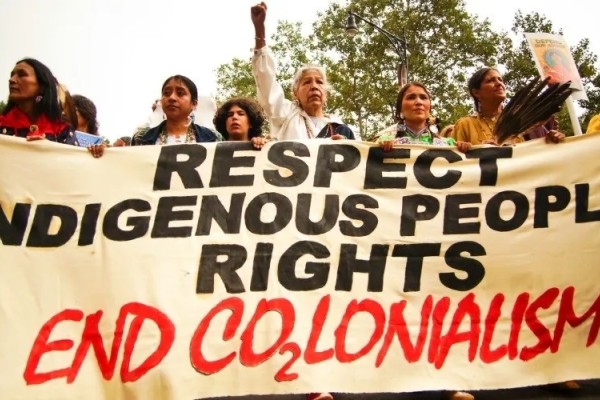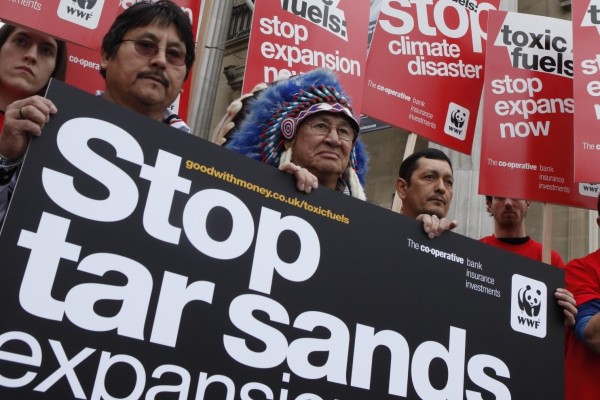Fairy Creek: a tree planter’s account of the blockades
With the campaign’s third annual resurgence in as many years, forestry workers need to organize in solidarity

Members of one of the Fairy Creek blockade camps set out to deter old-growth logging in cut blocks on southern Vancouver Island. Photo courtesy of Fairy Creek blockade.
In mid-August, accompanied by a few of my friends and coworkers, I rounded the bends, parted the mist, and crossed the bridges for the first time through the beautiful west coast of Vancouver Island on our way to lands of the Pachedaht and the Ditidaht, also known as Ada’itsx/Fairy Creek. What follows is a glimpse into my involvement in the Fairy Creek blockades, a movement I was drawn to as someone who works and organizes in the tree planting industry in British Columbia. There are still defenders (albeit fewer) at Fairy Creek, after 18 months of actively blockading, who fortified over the winter, enduring extreme weather. The blockades are currently experiencing a resurgence. The situation, of course, is grim, with police using tactics like pain compliance and illegal exclusion zones. Despite the sitting government’s explicit campaign against authorizing the logging of the old growth forest, and opposition from 78 percent of BC residents, John Horgan’s NDP government has nonetheless suppressed debate within the party on the Teal-Jones forest company’s extraction project, potentially accelerating a climate crisis that has had devastating impacts on BC, as we saw last summer.
In the face of such organized insanity it’s easy to despair. But I believe that anyone that works for a living has the power to challenge this system provided we understand how to organize. Although I was not the first (and certainly won’t be the last) tree planter to make my way to the blockades, the absence of organized labour in the sector has left it nearly bereft of solidarity efforts. I want to share a story about an experience I had at Fairy Creek that sheds light on the reality of Canadian capitalist ecocide. It is a rallying cry to my fellow tree-planters: If we want to challenge Canadian imperialism, we need to build worker power, starting now.
Activists at Fairy Creek. Their faces are blurred to protect the identities of those involved, who are facing multiple court proceedings. Photo supplied by the author.
After a few turtling missions I became well acquainted with the chaotic nature of decentralized blockading at Fairy Creek. For one thing there were communication difficulties. Getting messages to one another was largely done via satellite phone, and it took an hour at best to deliver a message. For another, given the unpredictable circumstances, what was true one moment could be invalid the next, and chances were good that there were police instigators among our ranks spreading misinformation. We did the best we could with the means we had.
On August 21, following an evening of preparation and meetings, we piled into vehicles en route to blockade a logging road. We packed some PVC pipes that had rebar sticking through them into the back of a truck. Dubbed “dragons” by the land defenders, they are designed to allow you to use a small piece of chain and a carabiner to lock your arm to the rebar in the PVC pipe and then lock yourself to something. The goal of the action that day was to get several “arrestables” to lock themselves to a gate on Granite Main in an attempt to prevent industry from using the road to move their machinery, and to stop the police from using it to limit the capabilities of the defenders. We arrived, and assembled into blob formation. We approached the gate, prompting an immediate reaction from the police. They pushed and pulled on us fruitlessly. I felt empowered knowing that I could look a cop in the eye, and tell them “NO!”
Within moments, the land defenders had locked themselves to the gate. Tensions mounted as we waited there. Before long, several police cruisers had pulled up Pacific Marine Road, disgorging officer after officer. I counted 32 armed RCMP officers surrounding us. Of these, I didn’t notice a single one who had any form of visible identification.
Next to the gate that we were blocking was a ditch a couple of meters deep that was home to a few aspen trees. Seeing an alternative to using the gate to get onto Granite Main, the police had cut down the vegetation in the ditch, and crafted a crude bridge. Within moments the cops drove one vehicle after another past our attempt to stop them. I could feel morale fading. I had a backpack on that was full of supplies, and I was under the impression that we were going to be pushing up to one of our camps from there. Apparently several others were too, because there were people yelling “Push!”
As the weight of everyone pushed forward, the cops pushed back against us. A person to my right was pressed against a concrete barrier, and shouted “Stop!”
The people at the back didn’t stop. Shouts of both “push” and “stop” could be heard. There was no unified understanding of what was happening. There was a cop directly ahead of me, a man likely only a few years my senior. He put his hand on my head, and pushed back against us. I resisted his force, and was pressed forward by those behind me. The person to my right who was being crushed against the concrete barrier pleaded with those around us to stop, to back up, but by that stage it had descended into a form of chaos. It seemed to be fight or flight, us versus them.
As we resisted, a police officer tripped over one of the roots of the trees that they had cut down to make a bridge, falling backwards into the ditch. Another cop saw this, and shouted “Man down!”
Immediately, the cops who were in direct contact with the land defenders on the outside of the amoeba all reached for their belts, retrieving little red bottles, and started spraying a steady stream of pepper spray.
They pulled at people’s face masks, and sprayed defenders at point blank range in the eyes and mouth. I was wearing a hat, and looked downward toward the ground in an attempt to protect my more vulnerable areas.
I heard screams of pain from friends I’d made over my time at Ada’itsx. I was sprayed down both of my arms, my back, and the side of my head. The police specifically targeted Indigenous people, fem-presenting individuals, and people of colour.
As the police used violence against us, the walls of the amoeba started to break down. They pulled at us, several officers to a person, eventually wrangling a few defenders. One land defender was thrown to the gravel road, prone, with the officer that threw them placing their knee on their head. After this officer had restrained this land defender, another officer who was wearing a buff that concealed their identity, seeing the chance to inflict gratuitous violence, punched the land defender in the ribs, before slamming their head against the road. As the defender was on their stomach, hands restrained behind their back, another cop gave another blast of pepper spray to the back of this land defender’s head. Several more were dragged along the ground by their hands which were restrained behind their back.
A middle-aged man pressed his head into my chest as we were being sprayed, as if I could envelop him and offer some form of protection. I put my arm over his exposed head, and pulled him in towards me. He had already been drenched in pepper spray, soaking the back of his head, and wetting his shirt and backpack. As long as I could help it, I wasn’t going to let this man be dragged away by the RCMP, so I held onto him, one arm laced through the back of his backpack, another over his head and onto his arms. It was a vulnerable moment. The cop that had previously had his hand on my head pushed the man I was holding, and when he recoiled, the cop sprayed pepper spray in his ear and across the side of his face towards his eyes. This same cop, who had a “medic” patch on his bullet-proof vest, picked up a guitar (heartfully dubbed “community guitar”) that had been shared by people at Sasquatch camp, and tossed it to another cop who stomped through the center of it.
Amidst the cacophonous din, the line started to break in earnest, land defenders pawed futilely at their eyes, trying to somehow make the intense pain go away. Anyone who remained within a few meters of the gate was arrested, including some media members. One cop, pepper spray at the ready, paced through the chaos looking for restrained land defenders to assault. The cops followed and attacked one individual even after this person had complied with an order to leave the area. Some activists regrouped on the other side of the road, attempting to neutralize the effects of the pepper spray with bottled water. We did our best to be as strong as we could in the face of an antagonist armed with chemical weapons.
Our efforts that day ultimately failed to prevent the police from accessing the road, and resulted only in the assault and degradation of the defenders. In the larger scheme of things—the attempt to disrupt business-as-usual—these failures must be taken in stride. I’m detailing these events here because those who show up need to know what can happen: When opposing a highly organized machine of colonial violence operated jointly by industry and government, we can expect to lose some of our battles, even as the war rages on. It was often representatives of Teal Jones, the company looking to log Fairy Creek, and not the police, that would read injunction orders to us.
In the long history of Canadian colonialism, the repression at Fairy Creek is not remotely unique. The RCMP, and their predecessors the North-West Mounted Police, were explicitly founded to pave the way for capitalist interests through the enforcement of racist segregationist policy and genocidal and exploitative seizure of Indigenous lands. The police we were facing were part of a branch of the RCMP who deal specifically with injunctions for resource companies. As part of their training, the officers are fed propaganda videos claiming that the protest is being funded by US interests in order to make Canadian logging less competitive.
It is no surprise, then, that we are seeing a continued pattern of opposition to Indigenous peoples’ right to self determination and control over natural resources on their traditional lands, even though the Supreme Court has recognized Aboriginal title time and time again in the last 50 years alone.
The state and, by extension, the police continually work in tandem with capitalist interests. Despite the signs of accelerated environmental collapse, resource extraction industries in Canada have been labeled “critical infrastructure” and the state has gone to great lengths to protect them, leaving a trail of trauma and violence in its wake.
According to a disclosure package given to an arrestee, Teal Jones, expects that “…the end product value of the products that it will produce from the timber sourced from TFL [tree farm lot] 46 is approximately $20 million…” while the RCMP has already spent over $10,000,000 in taxpayer dollars on enforcing a BC Court of Appeals’ injunction. It becomes clear where the police’s priorities lie, especially when considering funding for these oppressive operations is prioritized over, for example, the investigation of thousands of murdered and missing Indigenous women, girls, and two-spirit people.
In the midst of all of the police violence, the National Police Federation negotiated with the federal government for a seven percent increase to the police budget to take effect April 1, 2022, resulting in a roughly $20,000 pay increase for every officer, raising the annual salary of constables (the day-one rank of RCMP) from approximately $86,000 to around $106,000, while a staff sergeant can expect to make between $134,000 and $138,000. This represents more than double BC’s median annual salary of approximately $65,000.
Fairy Creek is an example of how industrial power works in conjunction with government against the claims of Indigenous peoples, scientific experts, a supermajority of the population, and even the mandate of the party in power. The formidable colonial exercise spearheaded by Teal Jones, the Trudeau Liberals and John Horgan’s NDP government in BC has been met with the largest protest movement (as measured by the number of arrests) in Canadian history.
This protest movement is part of a rich and often untold history of resistance to colonial and capitalist oppression on the part of activists from diverse communities: the labour movement, the women’s movement, Indigenous peoples, the LGBTQ+ community, and the environmental movement, among others. Its highlights include everything from the Winnipeg General Strike (1919), the Windsor Ford Strike (1945) and Québec’s Front Commun (1972) to contemporary manifestations such as Idle No More and the Wet’suwet’en struggle against the Coastal GasLink pipeline.
Activists at Fairy Creek. Their faces are blurred to protect the identities of those involved, who are facing multiple court proceedings. Photo supplied by the author.
I am appealing to all those who seek to oppose the power of Canadian capitalism, and especially to my fellow workers in silviculture, to channel the frustrations of the electoral system, the anxieties of the climate crisis, and the guilt of existing as a majority settler population on stolen land, into the effective tradition of solidarity unionism.
Instead of accepting an industry that acts in lockstep with other resource-based industries in Canada by creating boom and bust cycles in rural towns, destabilizing our environment, and furthering a history of systemic racism at the whim of multinational corporations, we can organize as a workforce. We can organize to empower workers, advocate for scientifically grounded environmental planning, and fight against a legacy of colonial violence towards Indigenous peoples.
Our effectiveness in organizing will not come from bureaucratic recognition by the colonial state, but from the relationships we foster with each other when we recognize our common purpose, and show up when it is challenged. This has been and always will be the source of our power. Ultimately the emancipation of the working class cannot move forward without the emancipation of all peoples deemed disposable by the sociopathic machine of colonial capitalism.
Personally, I am now dealing with the legal consequences of my participation in the blockades, with sentencing being booked into January 2023. A guilty plea means having to spend at least two weeks in jail, with the possibility of being sentenced to up to three months in prison. It remains to be seen what will happen when the cases go to trial. I know that the same organizing that is needed within the tree-planting industry to empower the workforce could be harnessed to fight on the blockades of Fairy Creek. And I harbour no illusions that the courts will contribute to bringing about the kinds of radical changes needed for humanity to survive in a world careening towards ecocide. The history of the oppressed has shown that we only win when we fight tooth and nail.
Morgan Bell is a tree planter and activist who has been working in the silviculture industry for five years. They are active in labour organizing in the province, and currently live in Victoria.










